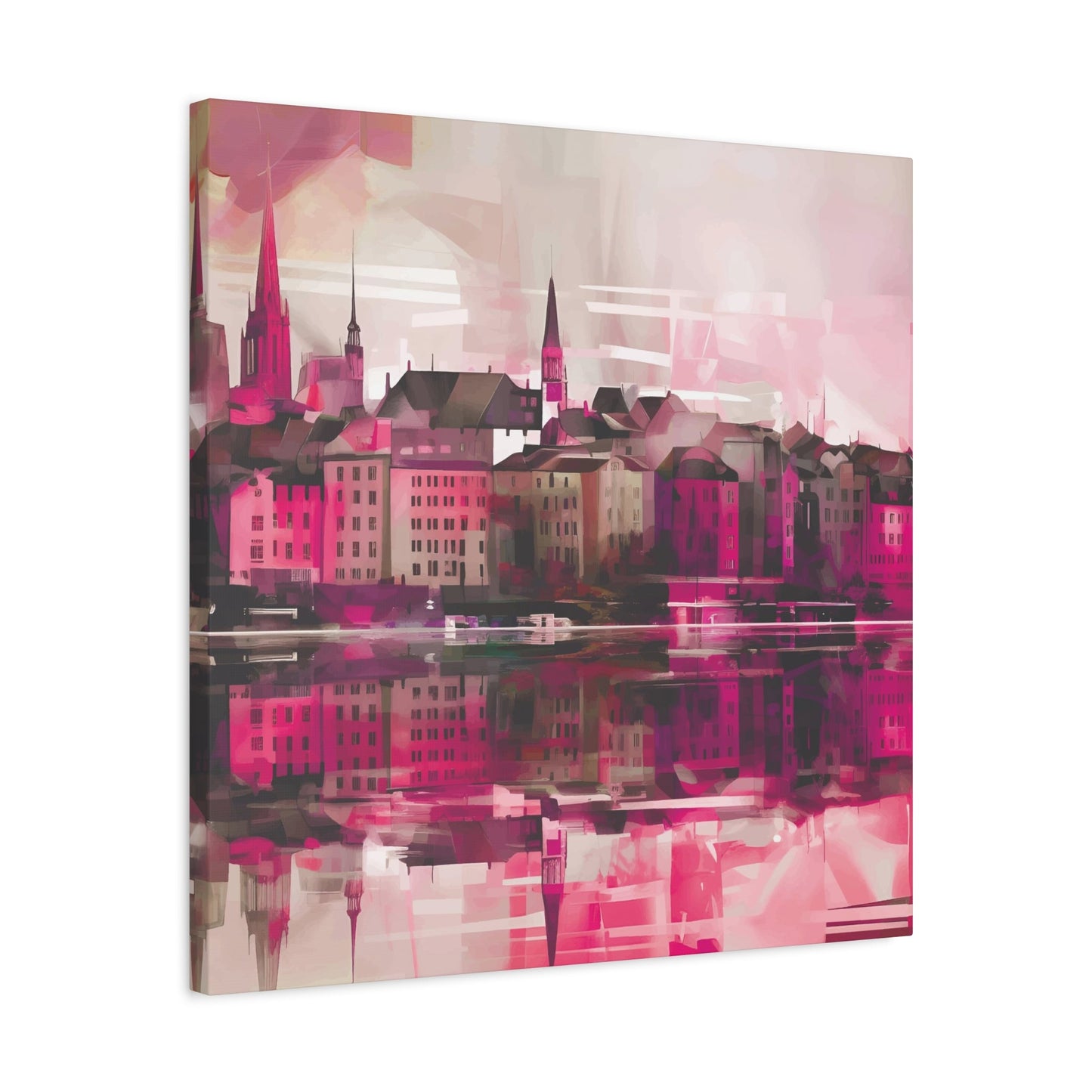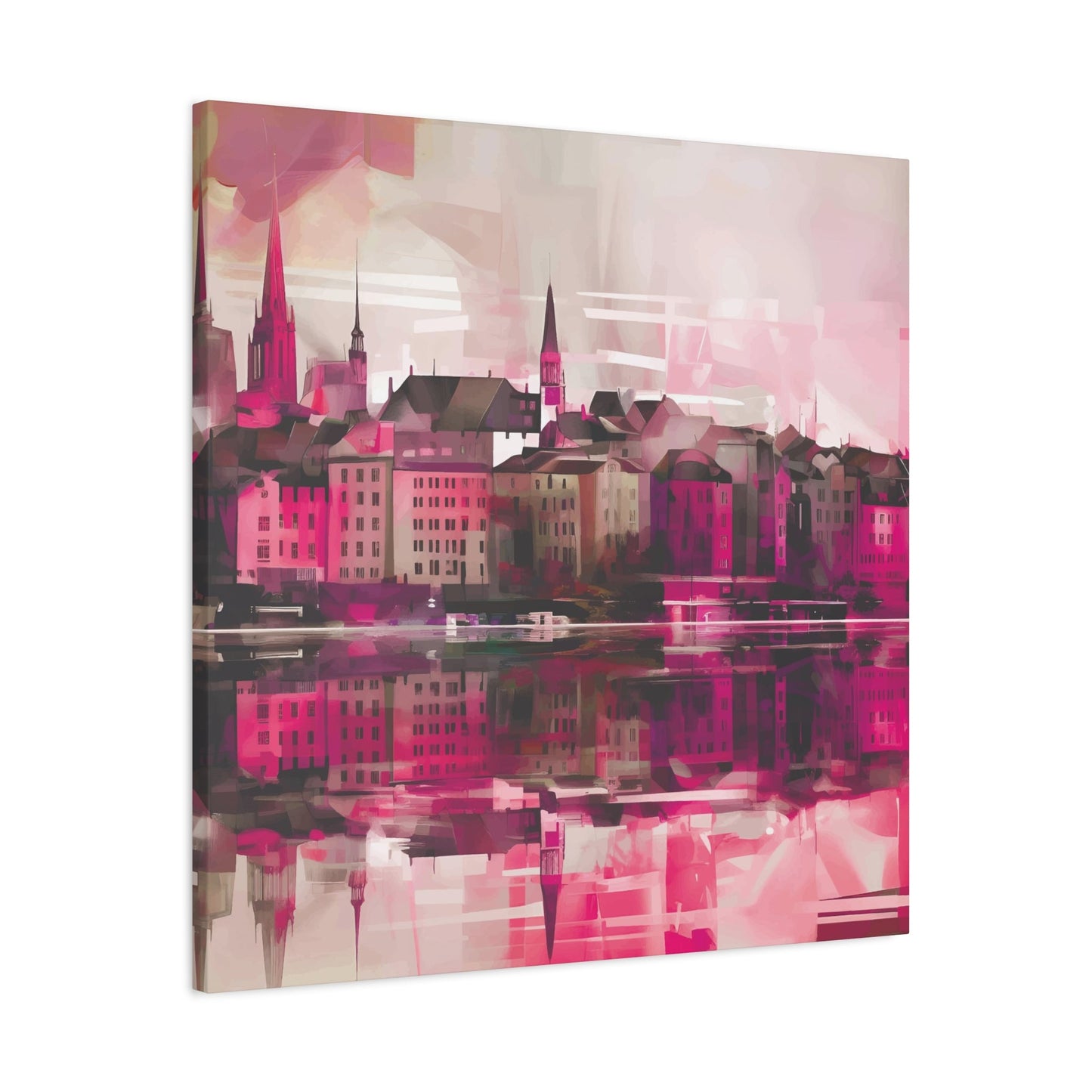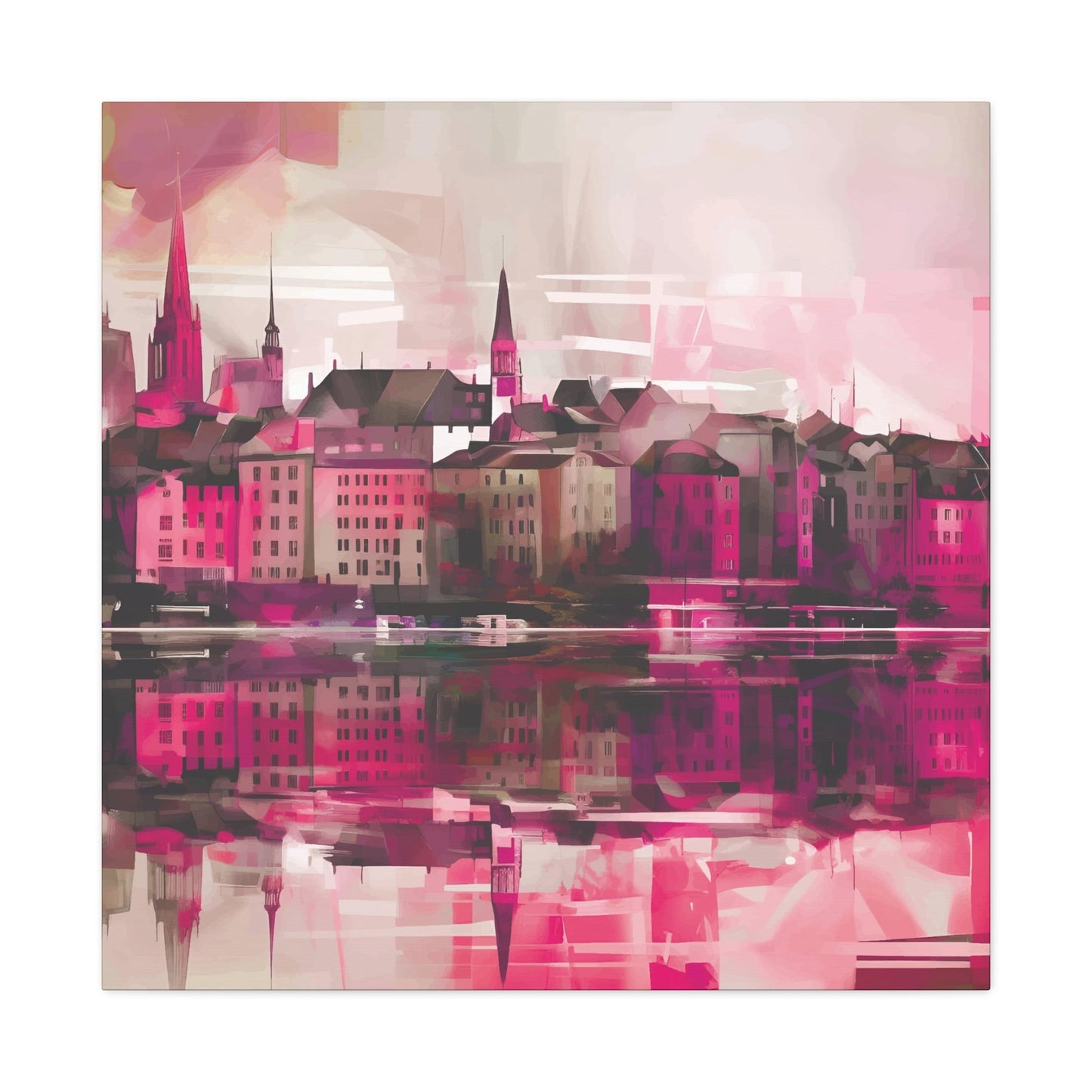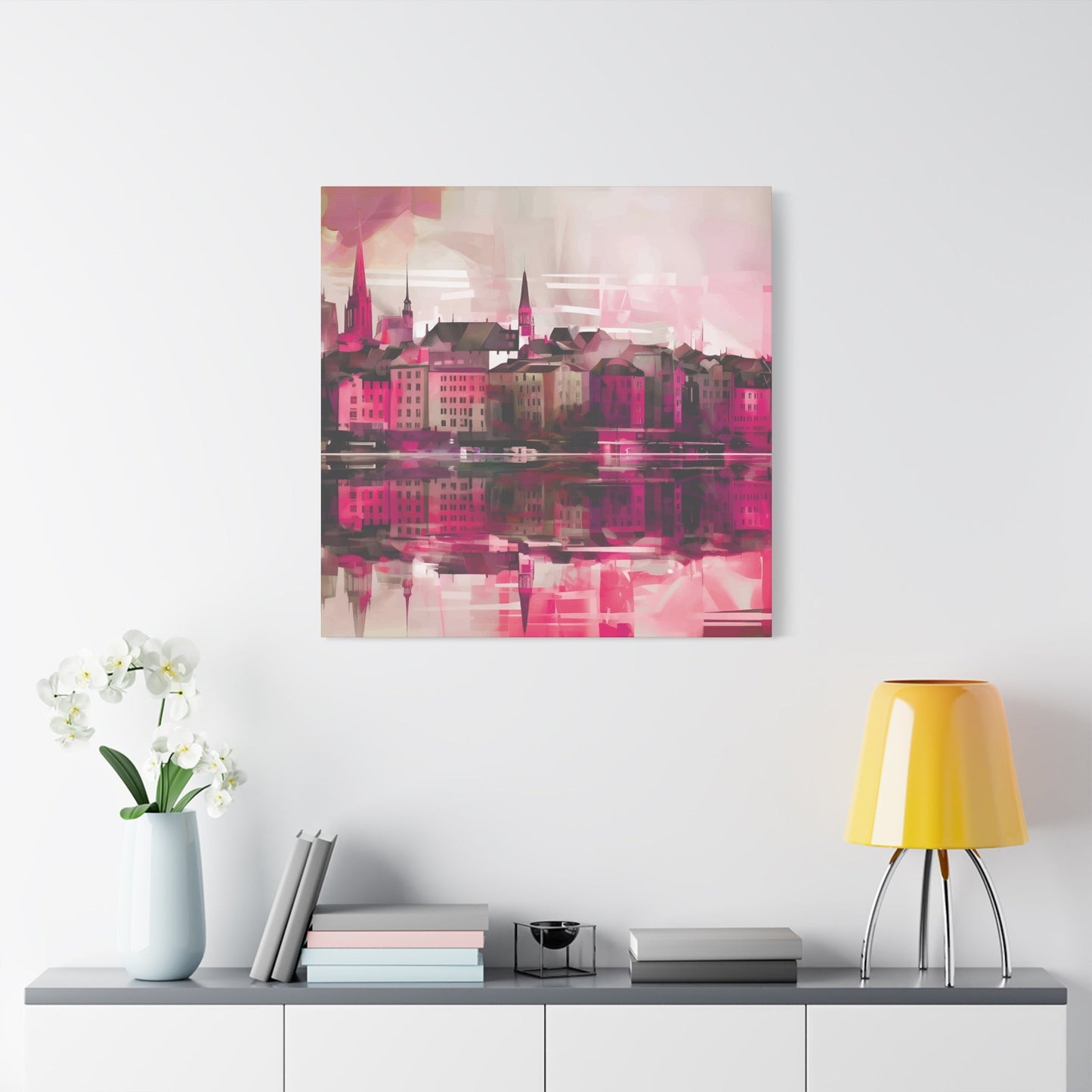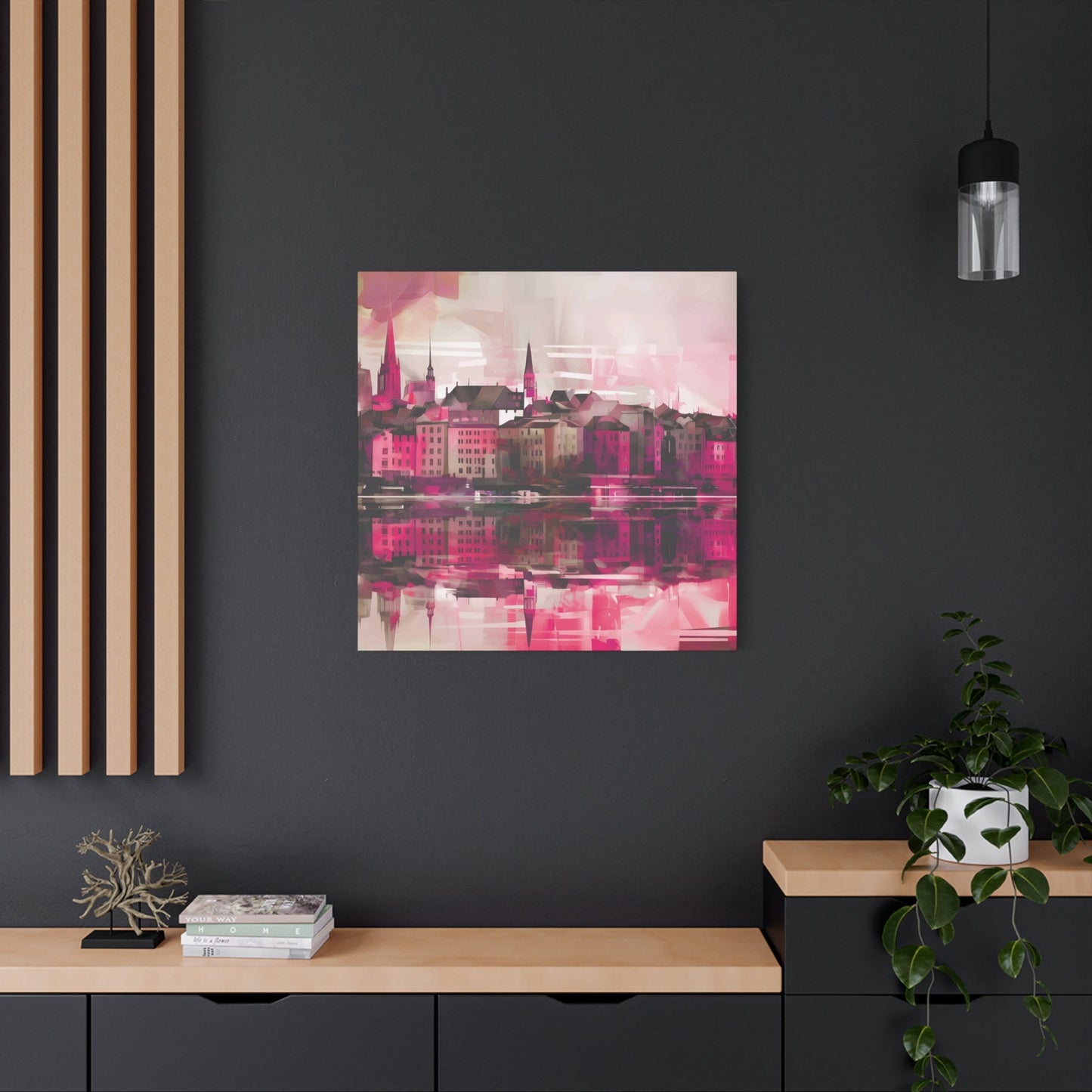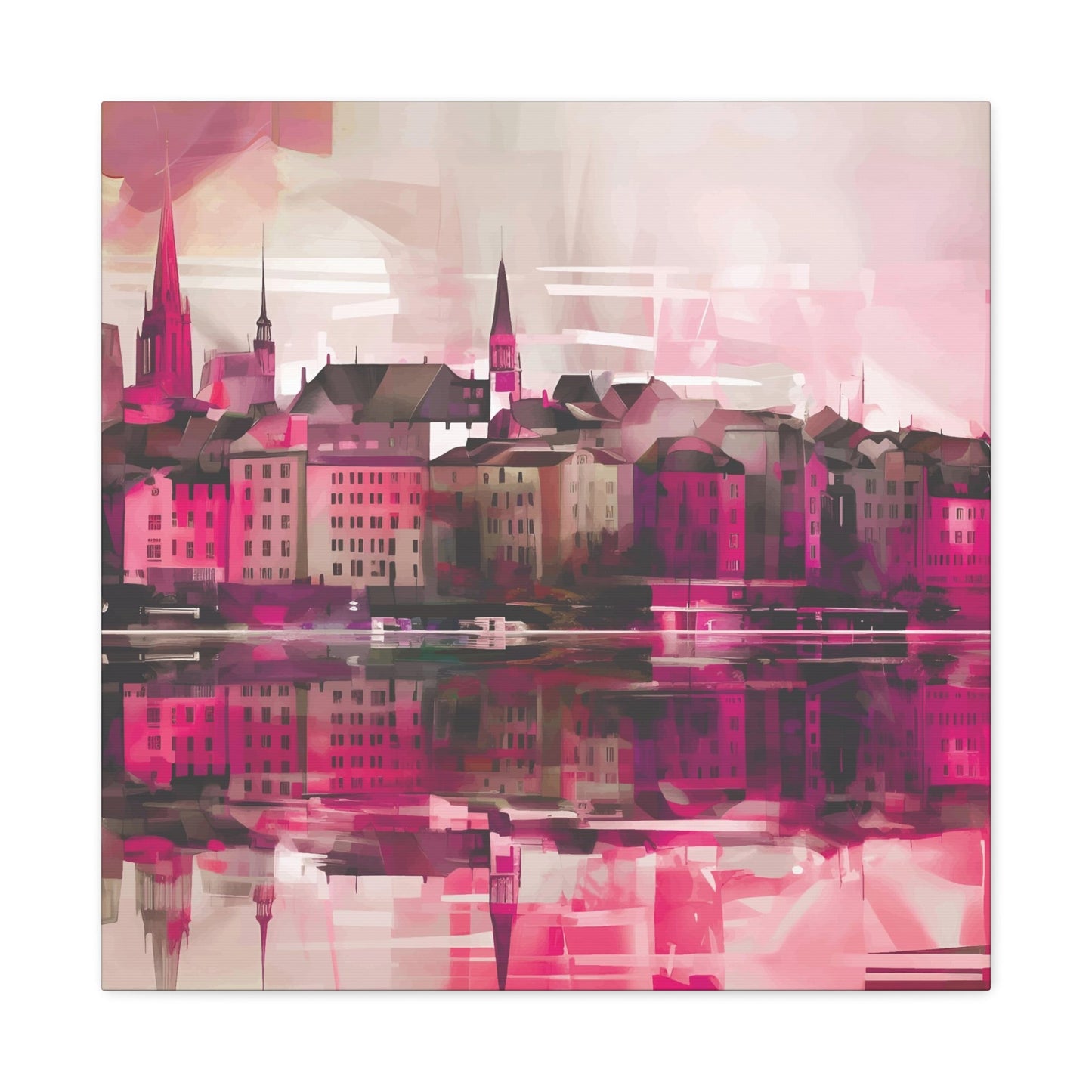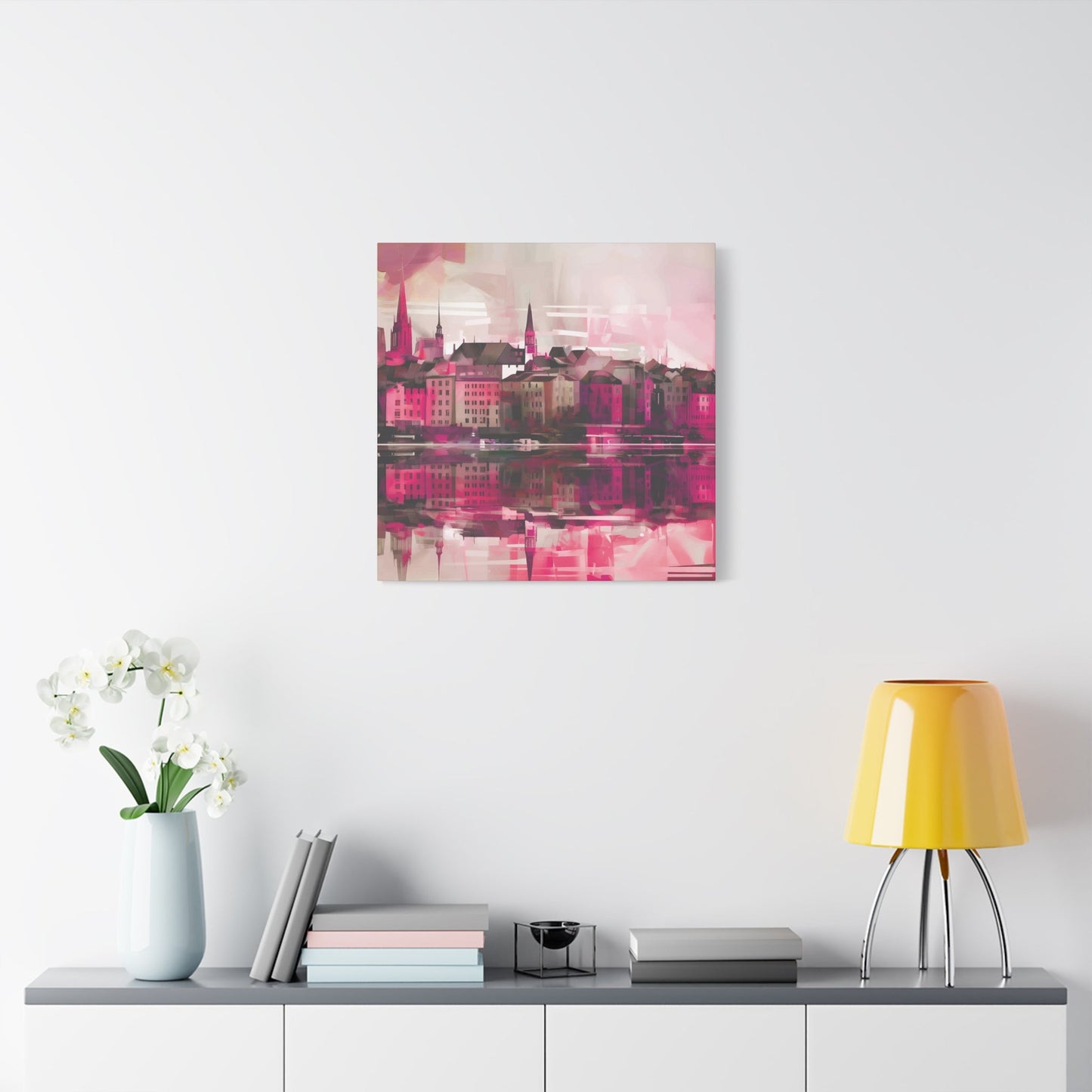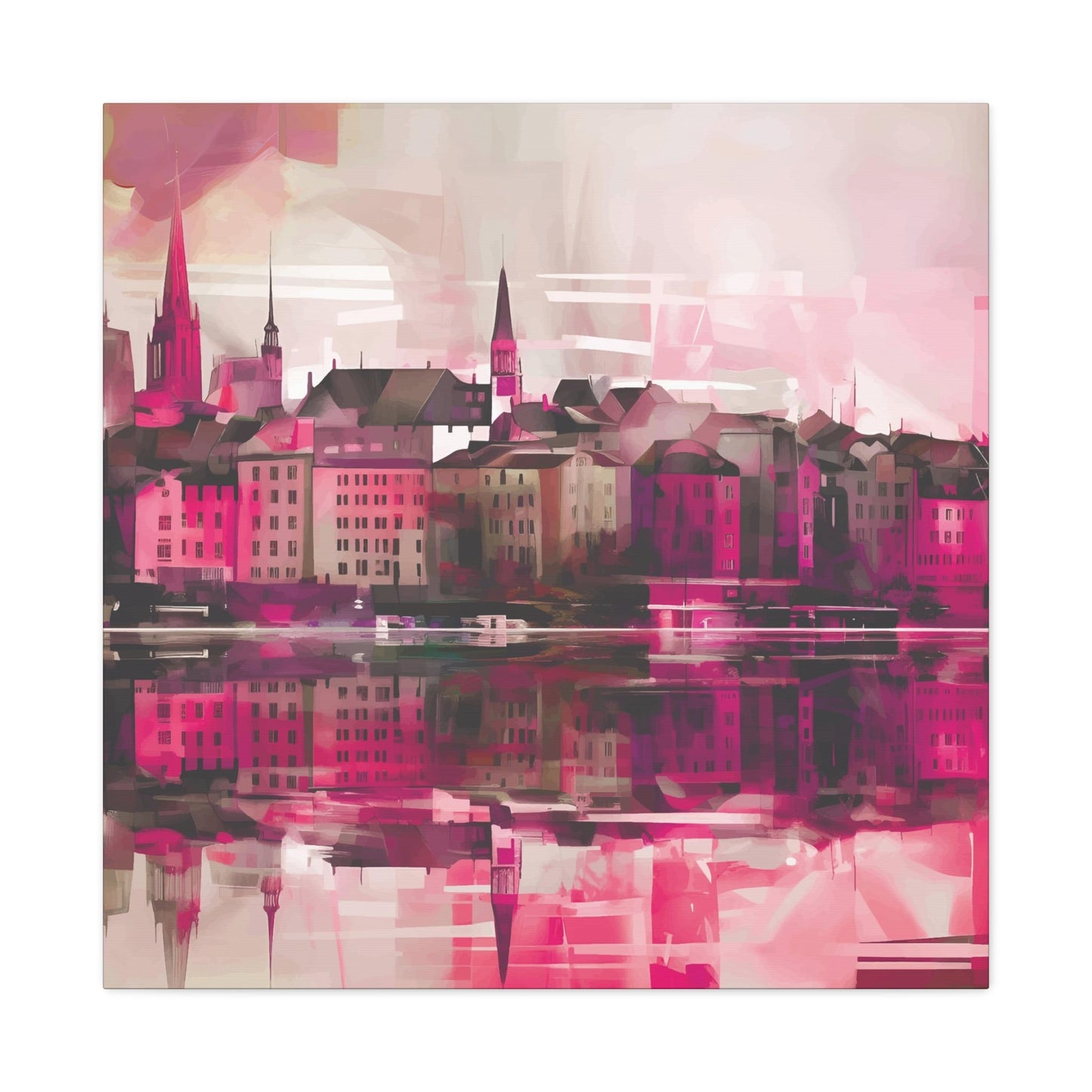Abstract Cityscape Wall Art: Creating Urban Aesthetic Through Metropolitan Artwork
Abstract metropolitan artwork represents a fascinating convergence of artistic expression and urban inspiration. This artistic movement captures the essence of city life through non-representational forms, colors, and compositions that evoke the energy, rhythm, and atmosphere of metropolitan environments. Unlike traditional landscape painting, abstract cityscape wall art distills urban experiences into their most essential visual elements.
The foundation of abstract metropolitan artwork lies in the artist's ability to translate the complex sensory experience of city living into visual language. This involves understanding how light reflects off glass buildings, how traffic creates patterns of movement, and how the vertical thrust of skyscrapers can be represented through bold geometric forms. Artists working in this medium often draw inspiration from the architectural lines, the interplay of shadows and light, and the constant motion that defines urban environments.
When examining abstract metropolitan pieces, viewers encounter a departure from literal representation toward emotional and atmospheric interpretation. The artwork might feature sweeping brushstrokes that suggest the flow of traffic, angular shapes that echo architectural forms, or color gradients that mirror the changing light throughout a city day. This approach allows artists to capture not just what a city looks like, but how it feels to experience urban life.
The historical development of abstract metropolitan art can be traced back to early twentieth-century movements that sought to represent the modern industrial world. Artists began to recognize that traditional realistic techniques were insufficient to capture the pace and complexity of urban life. They developed new visual languages that could express the simultaneity of urban experience - the way multiple events, sounds, and visual stimuli occur simultaneously in city environments.
Contemporary abstract metropolitan wall art continues this tradition while incorporating modern urban realities. Today's artists might reference digital screens, LED lighting, contemporary architectural styles, or the environmental concerns that shape modern city planning. This evolution ensures that abstract metropolitan artwork remains relevant and resonant with contemporary urban experiences.
The creation process for abstract metropolitan artwork often begins with observational sketching or photography in urban environments. Artists immerse themselves in city settings, documenting not just visual elements but emotional responses to urban stimuli. This preliminary research then informs the abstract interpretation, where realistic details are transformed into essential visual elements that communicate urban energy and atmosphere.
Color theory plays a crucial role in abstract metropolitan artwork. Artists must understand how different colors can evoke urban moods - the cool blues and grays of morning commutes, the warm oranges and reds of evening rush hour, or the stark contrast between artificial lighting and natural sky. These color relationships become the foundation for creating atmospheric depth and emotional resonance in abstract compositions.
Texture and mark-making techniques in abstract metropolitan wall art often mirror urban surfaces and experiences. Artists might use palette knives to create smooth surfaces reminiscent of glass buildings, or employ rough brushwork to suggest aged concrete and weathered urban materials. These textural elements add tactile quality to the artwork, engaging viewers on multiple sensory levels.
Color Theory and Application in Metropolitan Artwork
Color serves as the emotional backbone of abstract metropolitan wall art, carrying the power to transform any environment while evoking the specific atmosphere of urban living. The strategic use of color in cityscape artwork goes far beyond mere aesthetic appeal, functioning as a sophisticated language that communicates the complex moods, energies, and temporal qualities inherent in metropolitan environments.
The psychology of color in urban-inspired artwork draws from our collective associations with city life. Cool tones like steel blue, charcoal gray, and silver naturally evoke the industrial aspects of urban environments - the gleam of skyscrapers, the concrete of sidewalks, and the metallic surfaces that dominate city landscapes. These colors create a sense of sophistication and modernity that resonates with contemporary urban dwellers.
Warm colors in abstract metropolitan artwork serve different but equally important functions. Golden yellows might represent the warm glow of street lamps or the golden hour light filtering between buildings. Rich oranges and deep reds can suggest the energy of traffic lights, neon signs, or the vibrant life that pulses through urban arteries after dark. When balanced with cooler tones, these warm colors create dynamic tension that mirrors the constant interplay between human warmth and industrial coolness in city environments.
The concept of color temperature becomes particularly relevant in abstract metropolitan wall art. Cities experience dramatic shifts in lighting throughout the day, from the cool blue light of early morning to the warm golden tones of sunset, and finally to the artificial illumination that transforms urban landscapes after dark. Successful abstract metropolitan artwork captures these temporal shifts through strategic color temperature modulation.
Monochromatic color schemes in abstract metropolitan artwork can be particularly powerful, utilizing various shades, tints, and tones of a single color to create sophisticated urban atmospheres. A monochromatic blue composition might evoke the cool serenity of a city dawn, while a monochromatic red piece could capture the intensity and energy of urban nightlife. These single-color approaches require masterful handling of value relationships to maintain visual interest and depth.
Complementary color relationships in abstract metropolitan artwork create dynamic visual tension that mirrors the energy of city life. The classic pairing of blue and orange appears frequently in urban-inspired pieces, reflecting the natural occurrence of these colors in city environments - the blue of sky and shadows contrasting with the orange of artificial lighting and warm building materials. These complementary relationships create vibration and movement that energizes the viewing experience.
Analogous color schemes offer a more harmonious approach to abstract metropolitan wall art, using colors that sit adjacent to each other on the color wheel. A composition using blues, blue-greens, and greens might evoke the cooler, more serene aspects of urban parks or waterfront districts. Alternatively, a warm analogous scheme of reds, red-oranges, and oranges could capture the intensity of a busy commercial district or the warmth of community gathering places.
The use of neutral colors in abstract metropolitan artwork deserves special attention, as these colors form the foundation of urban color palettes. Grays, in particular, offer infinite variation and sophistication. From the light silver of polished steel to the deep charcoal of weathered concrete, gray provides a versatile foundation that can be warmed or cooled through the addition of subtle color undertones.
Accent colors in abstract metropolitan wall art function like urban focal points - bright splashes that draw attention and create visual hierarchy. These might be the brilliant red of a traffic light, the electric blue of a digital billboard, or the vibrant yellow of a taxi cab. Used sparingly and strategically, these accent colors can energize an entire composition while maintaining the sophisticated restraint characteristic of successful urban-inspired artwork.
The layering of colors in abstract metropolitan artwork mirrors the complexity of urban visual experiences, where multiple color sources interact and influence each other. Transparent glazes can create the effect of looking through multiple layers of urban atmosphere, while opaque color blocks might represent the solid architectural forms that define city skylines. This layering technique allows artists to create depth and complexity that reflects the multifaceted nature of urban environments.
Capturing Urban Energy Through Abstract Expression
The translation of urban energy into abstract visual form represents one of the most challenging and rewarding aspects of creating metropolitan wall art. Urban environments pulse with constant motion, sound, and activity, creating a sensory experience that traditional realistic artwork often struggles to capture fully. Abstract expression provides artists with the freedom to distill these dynamic qualities into pure visual energy.
Movement in abstract metropolitan artwork can be suggested through various artistic techniques. Diagonal lines and angular compositions create a sense of dynamism that mirrors the upward thrust of skyscrapers and the rapid movement of urban traffic. Flowing, curved lines might represent the organic movement of pedestrians through city streets or the gentle curves of modern architectural forms. The direction and quality of these lines communicate different types of urban energy - from the regulated flow of planned city grids to the chaotic vitality of organic urban growth.
Rhythm in abstract metropolitan wall art mirrors the various rhythms found in city life. The regular spacing of windows on a building facade might inspire a compositional rhythm based on repeated geometric elements. Alternatively, the irregular rhythm of urban life - the stop-and-start of traffic, the varied pace of pedestrian movement - can be captured through irregular spacing and varied mark-making. These rhythmic elements create visual music that resonates with viewers who recognize the familiar cadences of urban experience.
The concept of simultaneity, so central to urban experience, finds natural expression in abstract metropolitan artwork. Cities are environments where multiple events occur simultaneously - traffic moves while construction continues, pedestrians navigate while vendors sell, and day activities transition into night activities in an endless cycle. Abstract artwork can capture this simultaneity through overlapping forms, multiple focal points, and complex color interactions that suggest the layered nature of urban experience.
Energy levels in abstract metropolitan artwork can be controlled through various visual elements. High-energy compositions might feature bold contrasts, rapid mark-making, and complex overlapping forms that suggest the intensity of rush hour or the excitement of urban nightlife. Lower-energy compositions might use more subdued colors, smoother transitions, and simpler forms to evoke the quieter moments of urban life - early morning stillness or the peaceful atmosphere of residential neighborhoods.
The scale relationships in abstract metropolitan wall art often reflect the dramatic scale contrasts found in urban environments. Tiny human figures dwarfed by massive architectural forms, or intimate personal moments occurring within vast public environments - these scale relationships can be abstracted into compositional elements that communicate the unique quality of urban living where individual and collective experiences constantly intersect.
Texture plays a crucial role in capturing urban energy through abstract expression. The smooth surfaces of modern buildings, the rough texture of aged brick, the reflective quality of glass and metal - all of these tactile qualities can be translated into abstract mark-making techniques. Heavy impasto might suggest the roughness of concrete, while smooth, flowing brushwork could evoke the sleek surfaces of contemporary architecture.
Light quality in abstract metropolitan artwork must capture the unique characteristics of urban illumination. Cities create their own light environments through the combination of natural and artificial light sources. The harsh brightness of midday sun reflecting off glass buildings, the warm glow of street lamps creating pools of light in darkness, the colorful illumination of neon signs and digital displays - all of these light qualities can be abstracted into color and value relationships that evoke specific urban atmospheres.
Sound, though obviously not directly representable in visual art, can influence the creation of abstract metropolitan artwork. The constant hum of traffic might inspire gentle, consistent mark-making, while the sharp sounds of construction or emergency vehicles could translate into bold, interrupted brushstrokes. This synesthetic approach allows artists to create artwork that suggests the full sensory experience of urban living.
The psychological energy of urban environments also finds expression in abstract metropolitan wall art. Cities can be simultaneously stimulating and overwhelming, inspiring and exhausting. Abstract artwork can capture these psychological qualities through color choices, compositional complexity, and the overall visual weight of the piece. Understanding these psychological dimensions allows artists to create work that resonates emotionally with viewers who share urban experiences.
Selecting Metropolitan Artwork for Different Environments
The selection of abstract metropolitan wall art requires careful consideration of multiple factors including the intended environment, the existing aesthetic context, and the desired emotional impact. Different settings call for different approaches to urban-inspired artwork, and understanding these contextual requirements ensures that the chosen pieces enhance rather than compete with their surroundings.
Residential environments offer unique opportunities for incorporating abstract metropolitan artwork. In living rooms, larger scale pieces can serve as focal points that anchor the entire room design. These primary pieces should complement the overall color scheme while providing enough visual interest to reward extended viewing. The scale should be proportionate to the room size and ceiling height, with larger rooms accommodating more ambitious compositions and smaller rooms benefiting from more intimate pieces.
Bedroom environments require more subtle approaches to abstract metropolitan wall art. The goal in these private retreats is often to create a sense of calm sophistication rather than high energy stimulation. Softer color palettes, more harmonious compositions, and gentler interpretations of urban themes work best in bedroom settings. The artwork should contribute to a restful atmosphere while maintaining the sophisticated edge that urban-inspired art provides.
Kitchen and dining areas can accommodate more energetic abstract metropolitan artwork, as these are social gathering places where stimulating visual environments enhance conversation and community. Brighter colors and more dynamic compositions can work well in these settings, though consideration must be given to lighting conditions and the practical requirements of food preparation and dining activities.
Home office environments present unique challenges for abstract metropolitan wall art selection. The artwork should be sophisticated enough to create a professional atmosphere while providing enough visual interest to prevent the environment from becoming sterile. The key is finding pieces that inspire creativity and focus without becoming distracting during work activities. Often, pieces with strong geometric elements and professional color palettes work best in these settings.
Scale considerations vary significantly across different residential environments. High-ceilinged rooms can accommodate larger pieces that would overwhelm smaller environments, while compact rooms require more modest scales that don't visually shrink the available area. The viewing distance also affects appropriate scale - artwork intended for close viewing can incorporate more intricate details, while pieces meant to be seen from across a room should focus on bold, clear compositional elements.
Color coordination with existing decor requires careful balance between harmony and contrast. Abstract metropolitan artwork should complement the existing color scheme while providing enough contrast to maintain visual interest. Neutral color schemes offer flexibility in artwork selection, while bold existing colors may require more careful coordination to avoid visual conflict.
Lighting conditions significantly impact the effectiveness of abstract metropolitan wall art. Natural lighting changes throughout the day, so pieces should be selected with consideration for how they will appear under different lighting conditions. Artificial lighting can be used strategically to highlight artwork, but the color temperature and intensity of light sources affect how colors appear and how textures are revealed.
The architectural style of the environment influences appropriate artwork selection. Modern architectural settings naturally complement abstract metropolitan artwork, while traditional architectural contexts may require more careful integration. The goal is creating harmony between the artwork and its architectural context rather than fighting against existing design elements.
Personal lifestyle and aesthetic preferences play crucial roles in artwork selection. Individuals who thrive on visual stimulation might prefer more complex, energetic compositions, while those who value tranquility might choose simpler, more serene interpretations of urban themes. The artwork should reflect and enhance the inhabitant's personality and lifestyle preferences.
Investment considerations include both financial and emotional factors. Higher quality pieces may represent significant financial commitments, but they also provide long-term aesthetic satisfaction and potential value appreciation. The emotional investment in artwork that truly resonates ensures lasting satisfaction with the selection.
Comparing Abstract and Realistic Urban Artwork
The distinction between abstract and realistic approaches to urban artwork represents fundamentally different philosophies of artistic representation and emotional communication. Each approach offers unique advantages and appeals to different aesthetic sensibilities, making the comparison between them essential for anyone considering metropolitan wall art for their environment.
Realistic urban artwork focuses on accurate representation of identifiable city elements - specific buildings, recognizable street scenes, or particular urban landmarks. This approach provides immediate visual recognition and can create strong emotional connections through familiar imagery. Viewers can identify with specific locations, remember personal experiences associated with particular places, or feel connected to cities they know or wish to visit.
Abstract metropolitan artwork, in contrast, distills urban experience into essential visual elements that transcend specific locations or literal representations. This approach focuses on capturing the emotional essence, energy, and atmosphere of urban living rather than documenting particular places. The abstraction allows for more universal interpretation and emotional response, as viewers project their own urban experiences onto the artwork.
The level of detail differs significantly between these approaches. Realistic urban artwork often requires extensive detail to achieve convincing representation - accurate architectural proportions, correct perspective relationships, and careful attention to light and shadow patterns. Abstract metropolitan artwork can achieve powerful impact through bold simplification, focusing attention on essential elements while eliminating distracting details.
Color usage varies dramatically between realistic and abstract approaches. Realistic urban artwork must work within the constraints of observed color relationships, though artistic license allows for enhancement and emphasis. Abstract metropolitan artwork enjoys complete freedom in color selection, limited only by the artist's vision and the desired emotional impact. This freedom allows for more expressive and psychologically resonant color usage.
The creative process differs substantially between these approaches. Realistic urban artwork typically begins with careful observation, often involving extensive reference photography or plein air sketching. The artist must master technical skills in perspective, proportion, and realistic rendering. Abstract metropolitan artwork begins with emotional and atmospheric goals, with the artist translating feelings and impressions into visual form through more intuitive processes.
Compositional approaches vary between realistic and abstract urban artwork. Realistic pieces must respect the actual relationships between urban elements - buildings stand on ground, perspective follows logical rules, and scale relationships remain consistent. Abstract compositions enjoy complete freedom in spatial relationships, allowing for more dynamic and emotionally expressive arrangements of visual elements.
The viewing experience differs significantly between these approaches. Realistic urban artwork often provides immediate recognition and can be "read" quickly by viewers who identify familiar elements. Abstract metropolitan artwork requires more extended contemplation, with viewers gradually discovering relationships between colors, forms, and textures that create emotional resonance.
Cultural and personal associations play different roles in each approach. Realistic urban artwork can trigger specific memories and associations related to particular places or experiences. Abstract metropolitan artwork tends to evoke more general emotional responses related to urban living - the energy of city life, the sophistication of metropolitan culture, or the complexity of modern existence.
Decorative flexibility varies between these approaches. Realistic urban artwork often works best in settings that complement its specific cultural or geographical references. A realistic painting of New York City might feel out of place in a home with rustic or traditional decor. Abstract metropolitan artwork offers greater decorative flexibility, working well in various design contexts through its focus on color, form, and atmosphere rather than specific cultural references.
The longevity of appeal may differ between realistic and abstract approaches. Realistic artwork might become dated as urban environments change or as personal associations with particular places evolve. Abstract metropolitan artwork, focusing on timeless qualities of urban experience rather than specific locations or time periods, may maintain its relevance and appeal over longer periods.
Technical skill requirements differ between these approaches, though both demand artistic expertise. Realistic urban artwork requires mastery of traditional representational skills - perspective, proportion, light, and shadow. Abstract metropolitan artwork requires different skills - color theory, compositional balance, and the ability to translate emotional concepts into visual form.
Market considerations also vary between realistic and abstract urban artwork. Realistic pieces often appeal to viewers with connections to specific places, while abstract pieces appeal to broader audiences interested in contemporary aesthetic approaches. This can affect both the initial appeal and long-term value of the artwork.
Professional Applications for Metropolitan Wall Art
The integration of abstract metropolitan wall art into professional environments requires sophisticated understanding of workplace psychology, brand representation, and the role of visual elements in creating productive and inspiring work environments. Professional settings present unique opportunities and challenges for urban-inspired artwork, with success depending on careful alignment between artistic choices and business objectives.
Corporate office environments benefit significantly from well-chosen abstract metropolitan artwork that reinforces company culture and values. Organizations with urban headquarters or metropolitan focus can use urban-inspired art to strengthen their connection to city environments and the energy associated with urban business culture. The artwork serves as a visual reminder of the company's positioning within dynamic metropolitan markets.
The psychology of workplace productivity intersects importantly with abstract metropolitan wall art selection. Research indicates that visual stimulation in work environments can enhance creativity and problem-solving abilities, while excessive visual complexity can become distracting. Abstract metropolitan artwork offers the opportunity to provide appropriate visual stimulation without the distractions that might come from overly detailed realistic artwork.
Conference rooms and meeting areas present specific opportunities for abstract metropolitan artwork. These settings benefit from pieces that inspire creative thinking and sophisticated decision-making while maintaining professional atmospheres. Urban-inspired artwork in these environments can subtly communicate messages about innovation, forward-thinking, and metropolitan sophistication that enhance business discussions.
Reception areas serve as the first impression point for visitors, making artwork selection particularly important. Abstract metropolitan wall art in reception areas should immediately communicate the organization's professionalism, sophistication, and connection to contemporary urban culture. The scale and impact of artwork in these areas can be more dramatic than in work areas, as the primary goal is creating impressive first impressions rather than supporting ongoing work activities.
Executive offices require artwork that reflects leadership sophistication while remaining personally resonant for the executive. Abstract metropolitan artwork in these private work environments should enhance the executive's ability to think strategically about business challenges while providing visual respite during intense work periods. The artwork should complement the executive's personal aesthetic preferences while maintaining appropriate professional dignity.
Open office environments present unique challenges for abstract metropolitan artwork. The artwork must work effectively when viewed from multiple angles and distances, as employees move throughout the area. Color choices should complement the overall work environment without creating visual conflicts with computer screens or other technological equipment. The artwork should contribute to the energy of collaborative work without becoming overstimulating.
Healthcare facilities increasingly recognize the therapeutic value of appropriate artwork, and abstract metropolitan wall art can play important roles in urban healthcare settings. The connection to city life and urban energy can be particularly meaningful for patients and families dealing with medical challenges in metropolitan areas. The artwork should provide emotional support while maintaining the cleanliness and professionalism required in healthcare environments.
Educational institutions benefit from abstract metropolitan artwork that inspires creativity and intellectual curiosity. Urban-inspired pieces can help students connect their educational experiences with the broader metropolitan culture they will enter upon graduation. The artwork should stimulate intellectual engagement while supporting the focused attention required for learning activities.
Hospitality environments, including hotels and restaurants in urban settings, can use abstract metropolitan artwork to enhance the guest experience and reinforce location-specific branding. Urban-inspired art in these settings helps guests feel connected to the metropolitan culture they're visiting while creating memorable aesthetic experiences that enhance overall satisfaction.
Retail environments can incorporate abstract metropolitan artwork to create sophisticated shopping atmospheres that appeal to urban consumers. The artwork should complement the retail brand while creating environments that encourage extended browsing and positive associations with the shopping experience. Urban-inspired art can be particularly effective in attracting metropolitan customers who appreciate contemporary aesthetic approaches.
The scale considerations for professional environments often differ from residential applications. Professional settings frequently have larger wall areas and higher ceilings that can accommodate more ambitious artistic statements. However, the artwork must maintain its effectiveness when viewed during brief encounters, as many professional viewing situations involve people in transit rather than extended contemplation.
Maintenance and longevity considerations become particularly important in professional environments where artwork replacement can be costly and disruptive. Abstract metropolitan artwork should be selected for durability and timeless appeal that will continue to serve the organization's needs over extended periods. The investment in quality pieces pays dividends through years of effective service.
Budget considerations in professional environments often allow for higher quality artwork investments than typical residential purchases. Organizations can justify significant artwork investments through their impact on employee satisfaction, client impressions, and overall brand representation. The artwork becomes part of the organization's capital investment in creating effective work environments.
Decorative Applications and Arrangement Strategies
The successful integration of abstract metropolitan wall art into residential and commercial environments requires sophisticated understanding of decorative principles, spatial relationships, and visual hierarchy. Effective arrangement strategies transform individual pieces into cohesive decorative schemes that enhance the overall aesthetic quality of any environment.
Single statement pieces require careful positioning to maximize their visual impact without overwhelming the surrounding environment. Large-scale abstract metropolitan artwork functions best when given adequate surrounding area to "breathe" - empty wall areas that allow the eye to appreciate the piece without visual competition. The positioning height should align with average viewing eye level, typically ranging from 57 to 60 inches from floor to center of the artwork.
Gallery wall arrangements offer opportunities to create complex visual narratives using multiple pieces of abstract metropolitan artwork. Successful gallery walls require careful planning to balance visual weight, color relationships, and thematic coherence. The arrangement should have a clear focal point, usually the largest or most vibrant piece, with supporting pieces arranged to create visual flow and balance throughout the grouping.
Color coordination across multiple pieces in gallery wall arrangements requires sophisticated understanding of color relationships. Successful arrangements often employ a limited color palette that appears across all pieces, creating visual unity while allowing for individual piece variation. Alternatively, a single dominant color can be balanced with neutral tones across the arrangement, creating cohesion without monotony.
Spacing relationships in multi-piece arrangements follow specific guidelines that ensure visual coherence. Generally, pieces should be spaced 2-3 inches apart for intimate groupings, with larger spaces creating more formal, museum-like presentations. The overall arrangement should form a clear geometric shape - rectangle, square, or organic cluster - that creates visual unity.
Scale progression in gallery wall arrangements can create dynamic visual movement and hierarchy. Arranging pieces from largest to smallest can create a sense of perspective and depth, while alternating large and small pieces creates rhythmic visual movement. The key is maintaining overall balance while creating enough variation to sustain visual interest.
Lighting considerations significantly impact the effectiveness of abstract metropolitan artwork arrangements. Track lighting or picture lighting can be used to highlight individual pieces within gallery wall arrangements, while general room lighting should complement rather than compete with artwork illumination. Natural lighting changes throughout the day, so arrangements should be planned to work effectively under various lighting conditions.
Furniture relationships require careful coordination with artwork arrangements. Large statement pieces should be proportionally appropriate to the furniture scale beneath them - typically extending approximately 2/3 the width of sofas or other major furniture pieces. Gallery wall arrangements can extend beyond furniture boundaries, but should maintain visual connection to the furniture grouping.
Room architecture influences effective arrangement strategies. High ceilings can accommodate vertically oriented arrangements or larger scale pieces, while lower ceilings work better with horizontal arrangements or smaller scale pieces. Architectural features like windows, doorways, or built-in elements should be integrated into the overall arrangement strategy rather than competing with artwork placement.
Traffic flow considerations become important in areas where people move regularly. Artwork arrangements should enhance rather than impede natural movement patterns through rooms. In hallways or corridors, linear arrangements that follow the traffic flow work most effectively, while in gathering areas, arrangements should support conversation groupings and social interaction.
Seasonal flexibility can be incorporated into arrangement strategies, allowing for periodic changes that refresh the decorative impact without major renovation. This might involve rotating pieces within existing arrangements or having alternative pieces that can be substituted to create different seasonal moods or energy levels.
The psychological impact of different arrangement strategies varies significantly. Symmetrical arrangements create formal, balanced feelings that work well in traditional or professional settings. Asymmetrical arrangements create more dynamic, contemporary feelings that suit modern lifestyles and decorative approaches. The choice should align with the desired emotional atmosphere of the particular environment.
Budgetary considerations affect arrangement strategies, as multiple-piece arrangements require larger initial investments but offer greater decorative flexibility over time. Gallery wall arrangements can be built gradually, allowing for budget management while creating increasingly sophisticated decorative impact. Investment in quality framing becomes particularly important in multiple-piece arrangements where inconsistent framing quality becomes more noticeable.
Technology integration increasingly affects arrangement strategies, as modern homes and offices include various screens and digital displays. Abstract metropolitan artwork arrangements should complement rather than compete with these technological elements, often working best when positioned to create visual balance with screen-based elements rather than direct competition for attention.
Minimalist Approaches to Metropolitan Art
The intersection of minimalist design principles with abstract metropolitan wall art creates sophisticated aesthetic solutions that capture urban essence while maintaining the clarity and restraint characteristic of minimalist philosophy. This approach requires masterful editing to distill complex urban experiences into their most essential visual elements.
Minimalist metropolitan artwork relies heavily on powerful simplification, reducing complex cityscapes to their most fundamental geometric forms and color relationships. A minimalist interpretation of urban architecture might focus solely on the interplay between vertical and horizontal lines, creating compositions that suggest skyscrapers and city grids without literal representation. This reductive approach often proves more emotionally powerful than complex realistic depictions.
Color palette restriction becomes crucial in minimalist metropolitan art, often limiting compositions to two or three carefully chosen colors plus neutral tones. These limited palettes might focus on the cool grays and blues that dominate urban environments, or the warm oranges and reds of urban lighting systems. The restriction forces every color choice to carry significant compositional weight and emotional meaning.
The concept of negative area takes on special significance in minimalist metropolitan artwork. Empty areas in compositions become as important as painted areas, suggesting the open sky above cities or the breathing room necessary in dense urban environments. These negative areas provide visual rest and emphasize the power of the positive forms within the composition.
Geometric precision characterizes successful minimalist metropolitan art, with clean lines and exact shapes replacing the organic irregularities found in more complex approaches. This precision mirrors the planned geometry of urban architecture while creating compositions that feel ordered and intentional. The geometry should feel architectural without becoming coldly mechanical.
Scale relationships in minimalist metropolitan artwork often rely on dramatic contrasts between large and small elements, suggesting the scale relationships found in urban environments where massive buildings dwarf human figures. These scale contrasts can be achieved through simple geometric shapes that imply architectural monumentality without requiring detailed representation.
Material considerations become heightened in minimalist approaches, where every surface quality and texture choice carries significant visual weight. Smooth, flat paint application might suggest the sleek surfaces of modern architecture, while subtle texture could imply the weathered surfaces of older urban materials. The key is using material qualities purposefully rather than decoratively.
Compositional balance in minimalist metropolitan art requires sophisticated understanding of visual weight and spatial relationships. With fewer elements in the composition, each element must work harder to create overall balance and visual interest. The positioning of simple forms becomes critical to the success of the entire piece.
The emotional impact of minimalist metropolitan artwork often proves more powerful than complex alternatives because the simplified visual language allows for direct emotional connection without distracting details. Viewers can project their own urban experiences onto the essential forms and colors, creating personal emotional resonance with the artwork.
Installation considerations for minimalist metropolitan art require careful attention to presentation details. Clean, simple framing that doesn't compete with the artwork becomes essential. The surrounding wall area should be kept clear to allow the minimalist composition to achieve its full impact. Any distracting elements in the installation environment will undermine the carefully achieved simplicity.
Lighting for minimalist metropolitan artwork should be equally restrained and purposeful. The lighting should reveal the subtle qualities of the artwork without creating dramatic effects that compete with the composition's inherent restraint. Even lighting that maintains color accuracy becomes more important when working with limited color palettes.
The decorative integration of minimalist metropolitan art requires environments that support rather than compete with the artwork's refined aesthetic. Contemporary furniture with clean lines, uncluttered surroundings, and neutral color schemes provide appropriate contexts for minimalist urban-inspired pieces. The goal is creating harmony between artwork and environment through shared aesthetic principles.
Long-term satisfaction with minimalist metropolitan artwork often exceeds that of more complex pieces because the simplified visual language remains fresh and relevant over extended periods. The essential qualities that make cities compelling - energy, sophistication, geometric beauty - translate effectively into minimalist visual language that maintains its impact over time.
Strategic Placement and Display Techniques
The strategic placement of abstract metropolitan wall art requires sophisticated understanding of visual perception, spatial relationships, and the psychological impact of artwork positioning. Successful placement transforms individual pieces into integral environmental elements that enhance the overall aesthetic and functional quality of any room.
Height considerations form the foundation of effective artwork placement, with the center of most pieces positioned at eye level for average viewers, typically 57-60 inches from the floor. However, this standard requires adjustment based on ceiling height, furniture relationships, and the specific viewing situations. Higher placement works well in areas where viewers are primarily standing, while lower placement suits environments designed for seated viewing.
Viewing distance significantly affects optimal placement strategies. Pieces intended for close inspection can incorporate more detailed elements and subtle color variations, while artwork meant for across-the-room viewing should focus on bold, clear compositional elements that read effectively at distance. The relationship between artwork scale and viewing distance ensures that pieces maintain their visual impact in their intended environments.
Architectural integration requires careful consideration of existing structural elements. Abstract metropolitan artwork should complement rather than compete with architectural features like windows, doorways, columns, or built-in elements. The artwork can either echo architectural lines and proportions or provide deliberate contrast, but the relationship should feel intentional rather than accidental.
Lighting design plays a crucial role in effective artwork placement, with both natural and artificial light sources affecting how pieces appear throughout the day. Natural lighting changes in quality and intensity, so placement should consider how artwork will appear under morning, midday, and evening light conditions. Artificial lighting can be designed to complement artwork placement, with track lighting, picture lights, or strategic general lighting enhancing the viewing experience.
Furniture relationships require careful coordination to create cohesive room arrangements. Artwork placement should acknowledge major furniture pieces without being rigidly constrained by them. The scale relationship between artwork and furniture should feel proportional - generally, artwork should extend approximately two-thirds the width of major furniture pieces like sofas or beds, though creative variations can achieve interesting decorative effects.
Room circulation patterns influence optimal placement strategies, as artwork should enhance rather than impede natural movement through the environment. In high-traffic areas, placement should allow for comfortable viewing while maintaining clear passage. In more intimate areas, placement can accommodate closer inspection and extended contemplation.
Visual weight distribution requires strategic consideration when placing multiple pieces within a single environment. Abstract metropolitan artwork with bold colors or complex compositions carries significant visual weight and should be balanced with either similarly weighted pieces or appropriate negative areas. The goal is creating overall visual equilibrium that feels comfortable and intentional.
Cultural and personal significance can influence placement decisions, with more meaningful pieces positioned in locations that support extended viewing and contemplation. Primary living areas, private offices, or bedroom spaces might accommodate artwork with strong personal resonance, while public areas might focus more on creating impressive first impressions.
Flexibility considerations become important in environments that change function or arrangement regularly. Modular hanging systems allow for easy repositioning, while traditional hanging methods provide more permanent solutions. The choice should align with lifestyle needs and the likelihood of future rearrangement.
Maintenance accessibility affects long-term placement success, as artwork positioned in hard-to-reach locations may suffer from inadequate cleaning or maintenance. Regular dusting and occasional deeper cleaning become easier when artwork is positioned for reasonable access without requiring special equipment or professional services.
Climate considerations impact placement in environments with significant temperature or humidity variations. Areas near heating vents, air conditioning outlets, or sources of moisture should generally be avoided to protect artwork longevity. Stable environmental conditions support long-term artwork preservation while maintaining optimal appearance.
Technology integration increasingly affects placement decisions as homes and offices incorporate more screens, digital displays, and technological equipment. Abstract metropolitan artwork should complement rather than compete with these elements, often working best when positioned to create visual balance rather than direct competition for attention.
Seasonal considerations can influence placement strategies, particularly in areas with significant natural lighting changes throughout the year. Artwork positioned to take advantage of winter light might become overexposed during summer months, while pieces that look perfect in summer light might disappear during darker winter periods. Understanding these variations allows for strategic placement that works effectively year-round.
Contemporary Trends in Urban-Inspired Art
The evolving landscape of abstract metropolitan wall art reflects broader cultural shifts, technological advances, and changing urban experiences that shape contemporary artistic expression. Understanding current trends provides insight into the direction of urban-inspired art while identifying opportunities for collectors and decorators to engage with cutting-edge aesthetic developments.
Digital influence increasingly shapes contemporary abstract metropolitan artwork, with artists incorporating elements inspired by digital screens, LED displays, and the visual language of technology interfaces. This digital aesthetic often features crisp edges, glowing colors, and the kind of precise geometry associated with digital graphics. Artists working in this mode create pieces that feel distinctly contemporary while maintaining connection to traditional urban themes.
Environmental consciousness affects contemporary urban-inspired art, with many artists addressing sustainability concerns, climate change impacts on cities, and the relationship between urban development and environmental responsibility. These themes might be expressed through color choices that reference pollution or climate concerns, or compositional elements that suggest the tension between built environments and natural systems.
Mixed media approaches gain popularity in contemporary abstract metropolitan art, with artists combining traditional painting techniques with collage elements, textural materials, or even incorporated technological components. These mixed media pieces often reference the layered, complex nature of contemporary urban environments where digital and physical elements constantly interact.
Large scale installations and statement pieces reflect contemporary preferences for bold, impactful artwork that can compete with the visual complexity of modern environments. These oversized pieces often span multiple panels or occupy entire wall areas, creating immersive experiences that envelop viewers in urban-inspired atmospheres.
Minimalist interpretations of urban themes continue to evolve, with contemporary artists finding new ways to distill city experiences into essential visual elements. This minimalist approach often focuses on capturing the psychological and emotional essence of urban living rather than literal visual representation, creating pieces that feel both contemporary and timeless.
Color trends in contemporary abstract metropolitan art often reflect current urban lighting technologies and the changing visual character of cities. The prevalence of LED lighting creates new color possibilities, while the increasing use of colored architectural lighting in cities influences artist color choices. These contemporary color palettes often feature saturated, glowing colors that weren't available or relevant in earlier urban art.
Geometric abstraction continues to evolve in response to contemporary architectural developments. New building techniques, materials, and architectural forms inspire fresh geometric interpretations that keep abstract metropolitan art connected to current urban realities. The clean lines and precise forms of contemporary architecture translate into equally precise artistic compositions.
Conclusion
Abstract cityscape wall art offers a dynamic and innovative way to capture the vibrant energy and complexity of urban life. By blending imaginative interpretations with metropolitan themes, this style of artwork transforms city scenes into visually compelling compositions that celebrate the essence of modern living. Whether it’s the interplay of light and shadow, the geometry of skyscrapers, or the bustling movement of streets, abstract cityscape art invites viewers to experience the city through a fresh, artistic lens.
One of the key strengths of abstract cityscape wall art lies in its versatility and expressive potential. Unlike traditional cityscapes, which often focus on realism, abstract interpretations use color, form, and texture to evoke mood and atmosphere. This allows artists to highlight the emotional and sensory dimensions of urban environments—capturing the rhythm, chaos, and beauty that define city life. The result is artwork that not only decorates a space but also tells a story and stimulates the imagination.
Incorporating abstract cityscape art into your décor offers numerous benefits for creating a modern urban aesthetic. These pieces complement a wide range of interior design styles, from sleek minimalism to eclectic industrial, enhancing both residential and commercial spaces. Their bold lines, vivid colors, or subtle muted tones can anchor a room, serve as conversation starters, and infuse spaces with an energetic yet sophisticated vibe.
Moreover, abstract cityscape wall art reflects the diversity and constant evolution of metropolitan areas. Each piece can represent a different city’s unique character or blend elements from multiple urban landscapes, allowing for personalization and cultural expression. This makes abstract cityscape art not only visually appealing but also meaningful, resonating with those who feel a connection to the urban experience.
In conclusion, abstract cityscape wall art masterfully captures the spirit of metropolitan life through creative expression and innovative design. It transforms the architectural and social fabric of cities into compelling visual narratives that elevate any space. For anyone seeking to infuse their environment with an urban aesthetic that is both modern and emotionally engaging, abstract cityscape art offers an exciting and versatile solution.













